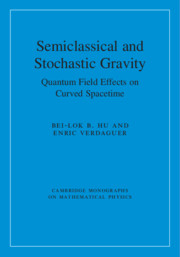Book contents
- Frontmatter
- Dedication
- Contents
- Preface
- 1 Overview: Main Themes. Key Issues. Reader’s Guide
- Part I Effective Action and Regularization, Stress Tensor and Fluctuations
- 2 ‘In-Out’ Effective Action. Dimensional Regularization
- 3 ‘In-In’ Effective Action. Stress Tensor. Thermal Fields
- 4 Stress-Energy Tensor and Correlators: Zeta-Function Method
- 5 Stress-Energy Tensor and Correlation. Point Separation
- Part II Infrared Behavior, 2PI, I/N, Backreaction and Semiclassical Gravity
- Part III Stochastic Gravity
- Part IV Cosmological and Black Hole Backreaction with Fluctuations
- Part V Quantum Curvature Fluctuations in de Sitter Spacetime
- References
- Index
4 - Stress-Energy Tensor and Correlators: Zeta-Function Method
from Part I - Effective Action and Regularization, Stress Tensor and Fluctuations
Published online by Cambridge University Press: 20 January 2020
- Frontmatter
- Dedication
- Contents
- Preface
- 1 Overview: Main Themes. Key Issues. Reader’s Guide
- Part I Effective Action and Regularization, Stress Tensor and Fluctuations
- 2 ‘In-Out’ Effective Action. Dimensional Regularization
- 3 ‘In-In’ Effective Action. Stress Tensor. Thermal Fields
- 4 Stress-Energy Tensor and Correlators: Zeta-Function Method
- 5 Stress-Energy Tensor and Correlation. Point Separation
- Part II Infrared Behavior, 2PI, I/N, Backreaction and Semiclassical Gravity
- Part III Stochastic Gravity
- Part IV Cosmological and Black Hole Backreaction with Fluctuations
- Part V Quantum Curvature Fluctuations in de Sitter Spacetime
- References
- Index
Summary
Zeta-function regularization is arguably the most elegant of the four major regularization methods used for quantum fields in curved spacetime, linked to the heat kernel and spectral theorems in mathematics. The only drawback is that it can only be applied to Riemannian spaces (also called Euclidean spaces), whose metrics have a ++++ signature, where the invariant operator is of the elliptic type, as opposed to the hyperbolic type in pseudo-Riemannian spaces (also called Lorentzian spaces) with a −+++ signature. Besides, the space needs to have sufficiently large symmetry that the spectrum of the invariant operator can be calculated explicitly in analytic form. In the first part we define the zeta function, showing how to calculate it in several representative spacetimes and how the zeta-function regularization scheme works. We relate it to the heat kernel and derive the effective Lagrangian from it via the Schwinger proper time formalism. In the second part we show how to obtain the correlation function of the stress-energy bitensor, also known as the noise kernel, from the second metric variation of the effective action. Noise kernel plays a central role in stochastic gravity as much as the expectation values of stress-energy tensor do for semiclassical gravity.
- Type
- Chapter
- Information
- Semiclassical and Stochastic GravityQuantum Field Effects on Curved Spacetime, pp. 113 - 149Publisher: Cambridge University PressPrint publication year: 2020

